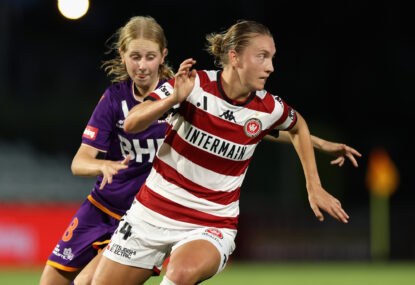With fans excited about the prospect of an expanded A-League Women’s (ALW) competition for 2022-23, the financial consequences for clubs remain a major obstacle.
It is understood the cost of bringing in a new women’s club costs the Australian Professional Leagues (APL) an extra $2 million per season, utilising the current 14-round competition length.
This cost blows out when an even number of extra clubs come in, with the cost of an additional ALW game per round adding to broadcasting and travel costs. If the competition was to go beyond 14 rounds, this figure becomes even larger.
All of this eats into APL dividends distributed to each club at the end of each season.
The APL confirmed that ViacomCBS will not pay additional broadcast revenue for an extra ALW game. It is also confirmed that Liberty won’t contribute additional sponsorship dollars.
With the APL underwriting player wages through its annual distribution to clubs, the whopping net cost of $2 million per additional club per season is a major hurdle.
APL CEO Danny Townsend has made it clear that any cost or net loss from expansion is seen as an investment for the future, though this attitude is not necessarily shared by other A-League clubs, most of whom are privately owned.
Canberra United, who only have an ALW team, are the only club which are not privately owned and are run by Capital Football.
It seems unlikely that Central Coast will come in for 2022-23, though this is not definitive. The Mariners’ new ownership may well make a late play for a licence.
Even Western United have not been formally ticked off by Football Australia (FA), with the game’s governing body getting the final say on ALW expansion in terms of clubs and the competition length. The APL confirmed that United were notionally approved last year, but they are still working through the formalities.
With women’s football growing in popularity, especially with the success of the Matildas, there is plenty of enthusiasm about growing our premier women’s competition but, as always, money will be a decisive factor.

(Photo by Thananuwat Srirasant/Getty Images)
The numbers in terms of TV audiences are getting better but seemingly not enough to convince ViacomCBS to pay more. Sadly, crowds are down on prior seasons, with COVID a factor, and a number of games have been moved to odd timeslots.
Channel Ten Bold had average TV audiences of 22,000 for Sunday afternoon – an improvement from 5000 during the Foxtel days. Ratings figures for Paramount are not released, with subscription numbers usually the defining factor in their performance measures.
The subscription numbers for Paramount using unique codes given to A-League club members has not yet been publicly revealed, though it is understood it is well short of the projected mark for 2021-22. The codes don’t separate between mens and womens.
It has been suggested the $32 million annual TV dividend from ViacomCBS can be reduced if targets are not met, though the actual value of any cash loss has been kept in commercial confidence.
TV ratings for Channel Ten for their Saturday night A-League Mens (ALM) games averaged a tick over 80,000, without including finals.
Crowds for the ALW were well down on expectations, with an average of only 1320 for 2021-22, not counting Perth Glory or Wellington Phoenix, who spent the bulk of the season playing in NSW.
The struggles experienced by the ALM this season has been a source of major concern, considering it generates the bulk of APL revenue.
The reality is the men’s competition has helped fund the women’s programs of most clubs since the beginning. With ALM crowds averaging 5595, along with the low TV ratings and low subscription levels for Paramount, there is a concern some clubs may curb spending. Whether this impacts the women’s programs at each club, only time will tell – though most clubs would be loath to take such a backward step.
The silver lining is the $140 million equity investment from SilverLake, a large chunk of which is expected to be invested next season.
The ALW competitions should be demanding their fair share of the investment, particularly leading up to the 2023 World Cup.
With Australia and New Zealand hosting the World Cup, a strong argument should be made to bring in marquee women’s players to build the anticipation. This would require a significant amount of money, with the best players likely to be on decent contracts in Europe or America. To convince them to come to Australia to acclimatise would require big cheques to be written.
Fan engagement is also an important exercise, with a strong argument being made that minimum wages should be increased for ALW players, giving them more time to go out to community clubs and schools.
More advertising is also a no brainer. Though to be fair, Ten did do a decent job through much of last season.
Time will tell how 2022-23 looks, but it will be an exciting season nonetheless, with a World Cup at the end of it.































































































